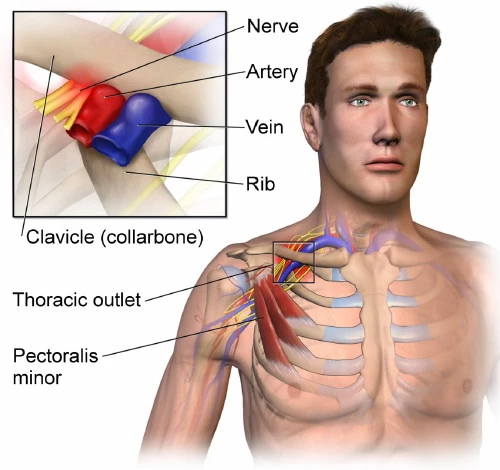Yoga Anatomy: Carpal Tunnel Syndrome

If you have carpal tunnel syndrome, you might feel shooting pain, burning, tingling, numbness, and weakness in your hand and wrist. You may have developed carpal tunnel syndrome from doing repetitive tasks with your arms and hands, like computer work, massage therapy, playing a musical instrument, or working on an assembly line.
While you may not be able to avoid the activity that caused your carpal tunnel syndrome, you can relieve your symptoms by changing the habitual movement patterns that have put you in pain.
How Nerve Compression Causes Carpal Tunnel Syndrome
The brachial plexus is a bundle of nerves formed from the lower four cervical spinal nerves and first thoracic spinal nerve. The plexus travels from the spinal cord through the neck, through the thoracic outlet, (see Illustration 1) and into the armpit.

Illustration 1: The Thoracic Outlet (left)
The brachial plexus branches apart into nerves that provide sensation and muscular control to the chest, shoulder, arm, and hand. One of these nerves is the median nerve.
Your median nerve passes between the carpal bones and the transverse carpal ligament of your wrist (see Illustration 2). When this nerve is compressed, you experience the painful symptoms of carpal tunnel syndrome.

Illustration 2: The Median Nerve Passing Through the Carpal Tunnel (right)
If you have carpal tunnel syndrome and do repetitive tasks with your hands, it’s very likely that your median nerve is being compressed as it passes through the carpal tunnel of your wrist. However, it’s important to remember that compression of this nerve can occur anywhere along its path: in your forearm, elbow, upper arm, thoracic outlet, and even where the nerves emerge from the spinal cord in between your vertebrae.
The most common cause of nerve compression is chronically tight muscles. For example, if you have tight muscles in your neck, these tight muscles can press your cervical vertebrae together, in turn compressing the nerves that pass through the spaces in between the vertebrae. So, nerve sensation that you experience in your wrist and hand can be the result of tight muscles in your neck—or chest, shoulder, arm, wrist, or hand.
How Our Habitual Movement Patterns Lead to Carpal Tunnel Syndrome
People who experience carpal tunnel syndrome typically have chronic muscle tension in the neck, shoulder, chest, waist, and back in addition to their arm, wrist, and hand. This muscle tension is the result of stress and habitual movement patterns that have caused muscle tension to gradually build up over time. As the muscles in the torso become tight and immobile, we’re forced to overuse our forearm, wrist, and hand to complete tasks.
The joints of our extremities, like the wrist joint, are designed to do less work than the joints closer to the center of our body. For example, in a reaching movement, most of the range of motion should come from bending or twisting of our spine. Then our shoulder blade will slide to allow more movement, and lastly, the joints of our arm and hand will articulate as needed in order to complete the task.
When we have limited range of motion in the core of our body, we demand far more movement from our wrist than the joint is equipped to do, and irritation, inflammation, and pain occur as a result.
How to Relieve Carpal Tunnel Syndrome
While taking a break from the activity that caused your carpal tunnel syndrome can provide the most immediate relief, it’s not always possible, especially if it’s how you earn your living. Icing your wrist joint and wearing a wrist brace may help to reduce inflammation and overuse of the joint. But to make lasting progress in relieving your symptoms, you should learn to release the chronic muscle tension and retrain the habitual movement patterns that are causing your pain.
How Yoga Practice May Help Symptoms of Carpal Tunnel Syndrome 
Given that yoga practice can help to mobilize and relieve tension in our bodies, the practice, in general, can complement strategies to relieve carpal tunnel syndrome. Knowing how to keep your shoulders healthy in yoga practice is essential.
Many yoga poses help to mobilize the core of your body. Twists are especially helpful in maintaining a healthy range of motion in the torso, which can, in turn, prevent overuse of the extremities.
Here’s more on yoga and carpal tunnel syndrome from YogaUOnline and Ram Rao, Ph.D.-Yoga for Healthy Wrists: Research Confirms Yoga is Effective for Carpal Tunnel Syndrome.
Strengthen your knowledge and experience of interoception; study with James Knight and YogaUOnline – Developing Interoception: Creating Embodiment Through Somatic Awakening.
Reprinted with permission from Somatic Movement Center.com
 Sarah Warren St. Pierre is a Certified Clinical Somatic Educator and the author of the book Why We’re In Pain. She was trained and certified at Somatic Systems Institute in Northampton, MA. Sarah has helped people with chronic muscle, and joint pain, sciatica, scoliosis, and other musculoskeletal conditions become pain-free by practicing Thomas Hanna’s groundbreaking method of Clinical Somatic Education. Sarah is passionate about empowering people to relieve their pain, improve their posture and movement, and prevent recurring injuries and physical degeneration.
Sarah Warren St. Pierre is a Certified Clinical Somatic Educator and the author of the book Why We’re In Pain. She was trained and certified at Somatic Systems Institute in Northampton, MA. Sarah has helped people with chronic muscle, and joint pain, sciatica, scoliosis, and other musculoskeletal conditions become pain-free by practicing Thomas Hanna’s groundbreaking method of Clinical Somatic Education. Sarah is passionate about empowering people to relieve their pain, improve their posture and movement, and prevent recurring injuries and physical degeneration.



